

Back to: Home American Stereoviews Underwood & Underwood
Pan-Chro Scope Corporation
Little is known about the Pan-Chro Scope Corporation, which produced two different sets of 48 lithograph stereoviews during the war. It was listed in the Indianapolis City Directory at the American Central Life Building, 8 East Market Street, from 1917 through 1924. The President was R. C. Cochran and the Vice-President John J. Murphy, followed by W. R. Drinkard in 1918. According to the directory, the firm was involved in advertising services. The overtly patriotic nature of these views and the absence of any other subjects suggested a connection with the Committee for Public Information (CPI), but there are no records in the National Archives to support that theory.
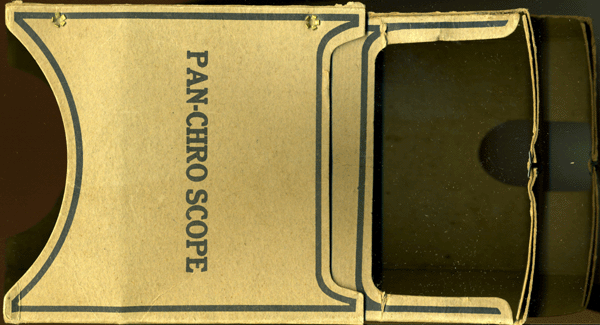 The
Pan-Chro Scope was a cheap cardboard stereoviewer consisting of an outer box
holding the stereo lenses and a sliding inner box for the stereoview. The
stereoviews were a nonstandard size, approximately 141mm x 81mm.
The
Pan-Chro Scope was a cheap cardboard stereoviewer consisting of an outer box
holding the stereo lenses and a sliding inner box for the stereoview. The
stereoviews were a nonstandard size, approximately 141mm x 81mm.
All the Pan-Chro Scope views were copyrighted by Underwood & Underwood, but no other evidence of a business relationship between the two companies has been found. The views were "authorized for use in the Pan-Chro Scope," a statement probably indicating CPI approval. When they were placed on sale in mid-1917, there were no current images. For instance, French soldiers shown in many of these images wore forage caps, not the helmet (casque Adrian) that had been placed into service in late 1915. Each view had text on the reverse, which on many of the views touted the advantages of stereoscopic viewing. For example, the first view of the first set stated "the movie will never reach the state of perfection until its pictures are made with a camera with two eyes."
Thirty stereoviews in Series Number One were a cross-section of older Underwood & Underwood war stereographs. The text on them often included quotes from American and French authors of books about the war. William J. (Billy) Robinson, an American who fought with the British Army at Ypres and wrote a book in 1916, My Fourteen Months at the Front, was quoted seven times. The remaining eighteen views in the first series showed US Navy warships, all prewar images that did not run afoul of CPI censorship regulations. Title List
 |
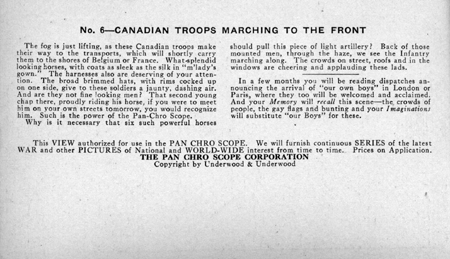 |
| Underwood & Underwood titled this image, 11912, as Canadian troops and also as Australian artillery in their World War sets. The text "In a few months you will be reading dispatches announcing the arrival of 'our own boys' in London or Paris," dates this series to May or June 1917. | |
 |
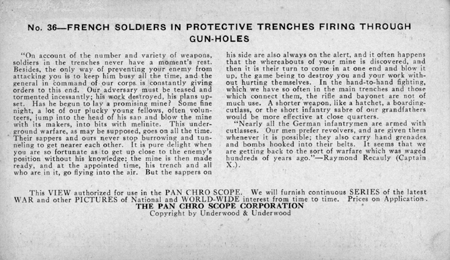 |
| The entire text on the reverse of this image (U&U 11978) is taken from a book by a French author, Raymond Recouly (Captain X). He wrote several biographies of French marshals and a book on the Russian Revolution. The image shows French soldiers in forage caps, dating it to 1914 or 1915. | |
 |
 |
| Underwood & Underwood included this view in their World War sets as 10051, although it showed the Great White Fleet getting under way in 1907. Like several views in this series, the text discussed how the mind processes stereo images. | |
Series Number Two was considerably different from Series Number One. The first 20 stereoviews showed the nation's growing preparedness in 1917. Twelve showed training at the Army camp at Plattsburg, NY, which had been the site of the voluntary Regular Army Camps of Instruction for Business and Professional Men in 1915 and 1916. Six showed patriotic ceremonies in New York City and two in Pittsburgh. Several of the Plattsburg and New York views were shot on Decoration Day, 30 May 1917. At that time, Decoration Day was celebrated in the northern states to honor Civil War dead; after World War One, it was renamed Memorial Day and its scope broadened to include all the dead from our country's wars. The remaining 28 views were standard Underwood & Underwood war stereoviews. Title List
 |
 |
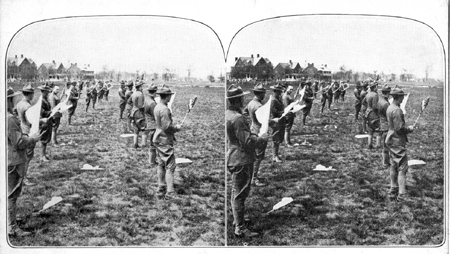 |
 |
| According to stereographs in the Keystone-Mast Collection, these views were Underwood & Underwood 13162 and 13228, respectively, but actual photos on Underwood & Underwood mounts have not been seen. The images were acceptable propaganda, but were probably not popular for purchase. | |
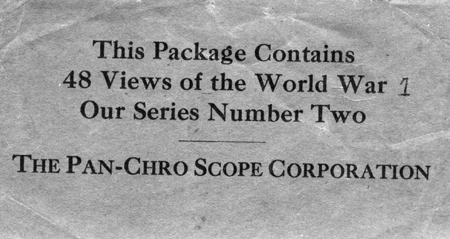 |
The paper wrapper for Series Two. Note the addition of a handwritten "1" after "World War" by a subsequent owner. |
Thanks to Suzanne Crowe, Reference Librarian of the Indiana Historical Society, for checking the directory entries.
Copyright © 2007 Great War Photos. All rights reserved